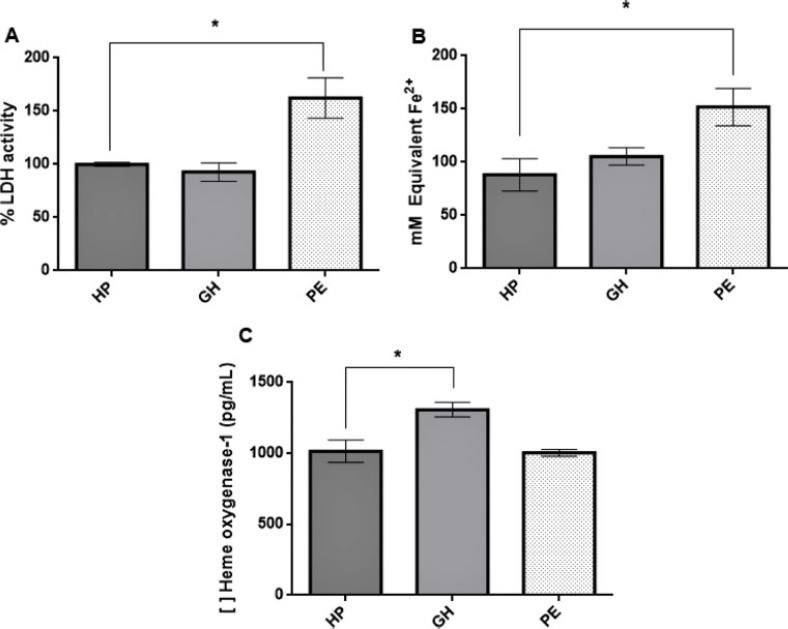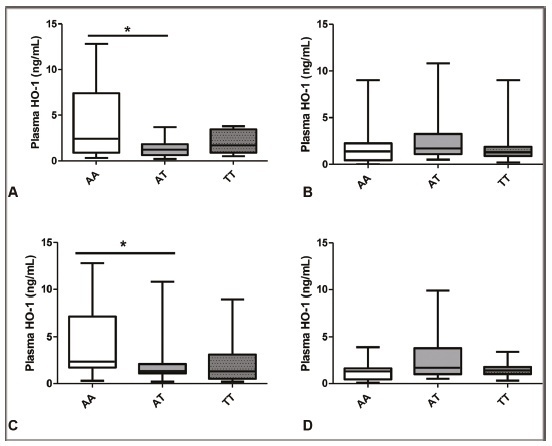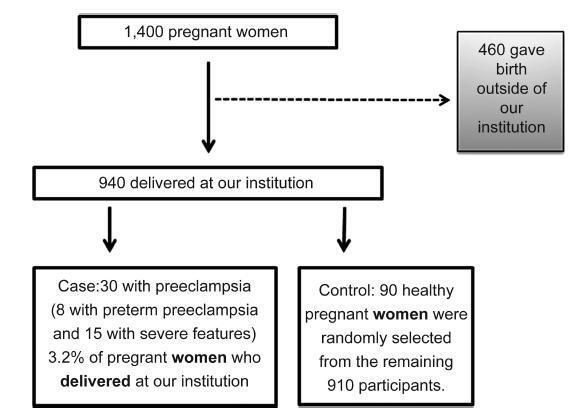You searched for:"Valeria Cristina Sandrim"
We found (6) results for your search.-
Vascular contraction of umbilical arteries of pregnant women with preeclampsia
Rev Bras Ginecol Obstet. 2024;46:e-rbgo2
Summary
Vascular contraction of umbilical arteries of pregnant women with preeclampsia
Rev Bras Ginecol Obstet. 2024;46:e-rbgo2
Views211See moreAbstract
Objective:
Potassium channels have an important role in the vascular adaptation during pregnancy and a reduction in the expression of adenosine triphosphate-sensitive potassium channels (Katp) has been linked to preeclampsia. Activation of Katp induces vasodilation; however, no previous study has been conducted to evaluate the effects of the inhibition of these channels in the contractility of preeclamptic arteries. Glibenclamide is an oral antihyperglycemic agent that inhibits Katp and has been widely used in vascular studies.
Methods:
To investigate the effects of the inhibition of Katp, umbilical arteries of preeclamptic women and women with healthy pregnancies were assessed by vascular contractility experiments, in the presence or absence of glibenclamide. The umbilical arteries were challenged with cumulative concentrations of potassium chloride (KCl) and serotonin.
Results:
There were no differences between the groups concerning the maternal age and gestational age of the patients. The percentage of smokers, caucasians and primiparae per group was also similar. On the other hand, blood pressure parameters were elevated in the preeclamptic group. In addition, the preeclamptic group presented a significantly higher body mass index. The newborns of both groups presented similar APGAR scores and weights.
Conclusion:
In the presence of glibenclamide, there was an increase in the KCl-induced contractions only in vessels from the PE group, showing a possible involvement of these channels in the disorder.

-
Original Article
Preeclampsia and Gestational Hypertension: Biochemical and Antioxidant Features in Vitro Might Help Understand Different Outcomes
Rev Bras Ginecol Obstet. 2021;43(12):894-903
Summary
Original ArticlePreeclampsia and Gestational Hypertension: Biochemical and Antioxidant Features in Vitro Might Help Understand Different Outcomes
Rev Bras Ginecol Obstet. 2021;43(12):894-903
Views0See moreAbstract
Objective
Gestational hypertension (GH) is characterized by increased blood pressure after the 20th gestational week; the presence of proteinuria and/or signs of end-organ damage indicate preeclampsia (PE). Heme oxygenase-1 (HO-1) is an antioxidant enzyme with an important role in maintaining endothelial function, and induction of HO-1 by certain molecules shows potential in attenuating the condition’s effects over endothelial tissue. HO-1 production can also be stimulated by potassium iodide (KI). Therefore, we evaluated the effects of KI over HO-1 expression in human umbilical vein endothelial cells (HUVECs) incubated with plasma from women diagnosed with GH or PE.
Methods
Human umbilical vein endothelial cells were incubated with a pool of plasma of healthy pregnant women (n = 12), pregnant women diagnosed with GH (n = 10) or preeclamptic women (n = 11)with or without the addition of KI for 24 hours to evaluate its effect on this enzyme expression. Analysis of variance was performed followed by Dunnet’s test for multiple comparisons between groups only or between groups with addition of KI (p ≤ 0.05).
Results
KI solution (1,000 µM) reduced HO-1 in the gestational hypertension group (p = 0.0018) and cytotoxicity in the preeclamptic group (p = 0.0143); treatment with KI reduced plasma cytotoxicity but did not affect the preeclamptic group’s HO-1 expression.
Conclusion
Our findings suggest that KI alleviates oxidative stress leading to decreased HO-1 expression; plasma from preeclamptic women did not induce the enzyme’s expression in HUVECs, and we hypothesize that this is possibly due to inhibitory post-transcriptional mechanisms in response to overexpression of this enzyme during early pregnancy.

-
Original Article
Interaction Between NOS3 and HMOX1 on Antihypertensive Drug Responsiveness in Preeclampsia
Rev Bras Ginecol Obstet. 2020;42(8):460-467
Summary
Original ArticleInteraction Between NOS3 and HMOX1 on Antihypertensive Drug Responsiveness in Preeclampsia
Rev Bras Ginecol Obstet. 2020;42(8):460-467
Views7See moreAbstract
Objective
We examined the interaction of polymorphisms in the genes heme oxygenase- 1 (HMOX1) and nitric oxide synthase (NOS3) in patients with preeclampsia (PE) as well as the responsiveness to methyldopa and to total antihypertensive therapy.
Methods
The genes HMOX1 (rs2071746, A/T) and NOS3 (rs1799983, G/T) were genotyped using TaqMan allele discrimination assays (Applied Biosystems, Foster City, CA, USA ), and the levels of enzyme heme oxygenase-1 (HO-1) were measured using enzyme-linked immunosorbent assay (ELISA).
Results
We found interactions between genotypes of the HMOX-1 and NOS3 genes and responsiveness tomethyldopa and that PE genotyped as AT presents lower levels of protein HO-1 compared with AA.
Conclusion
We found interactions between the HMOX-1 and NOS3 genes and responsiveness to methyldopa and that the HMOX1 polymorphism affects the levels of enzyme HO-1 in responsiveness to methyldopa and to total antihypertensive therapy. These data suggest impact of the combination of these two polymorphisms on antihypertensive responsiveness in PE.

-
Original Article
Circulating Tissue Inhibitor of Metalloproteinase-4 levels are not a Predictor of Preeclampsia in the period between 20 and 25 Weeks of Gestation
Rev Bras Ginecol Obstet. 2018;40(12):757-762
Summary
Original ArticleCirculating Tissue Inhibitor of Metalloproteinase-4 levels are not a Predictor of Preeclampsia in the period between 20 and 25 Weeks of Gestation
Rev Bras Ginecol Obstet. 2018;40(12):757-762
Views0See moreAbstract
Objective
To evaluate whether the circulating level of tissue inhibitor of metalloproteinase- 4 (TIMP-4) in the period between 20 and 25 weeks of gestation is a predictor of preeclampsia.
Methods
We have performed a case-control study, nested in a prospective study cohort in Ribeirão Preto, in the state of São Paulo, Brazil. Of the 1,400 pregnant women evaluated between 20 and 25 weeks of gestation, 460 delivered in hospitals outside of our institution. Of the 940 pregnant women who completed the protocol, 30 developed preeclampsia. Healthy pregnant women (controls, n = 90) were randomly selected from the remaining 910 participants. From blood samples collected between 20 and 25 weeks of gestation, we performed a screening of 55 angiogenesis-related proteins in 4 cases and 4 controls. The protein TIMP-4 was the most differentially expressed between cases and controls. Therefore, wemeasured this protein in all cases (n = 30) and controls selected (n = 90).
Results
There were no differences in the plasma TIMP-4 levels of cases compared with controls (1,144 263 versus 1,160 362 pg/mL, respectively; p > 0.05).
Conclusion
Plasma TIMP-4 levels were not altered at 20 to 25 weeks of gestation, before the manifestation of clinical symptoms; therefore, they are not good predictors of the development of preeclampsia.

-
Original Article
Clinical and laboratory characteristics of pregnant women with preeclampsia versus gestational hypertension
Rev Bras Ginecol Obstet. 2014;36(10):461-466
Summary
Original ArticleClinical and laboratory characteristics of pregnant women with preeclampsia versus gestational hypertension
Rev Bras Ginecol Obstet. 2014;36(10):461-466
DOI 10.1590/SO100-720320140005029
Views1See morePURPOSE:
To compare clinical and laboratory characteristics, obstetric and perinatal outcomes of patients with pre-eclampsia versus gestational hypertension.
METHODS:
A retrospective study was carried out to analyze medical records of patients diagnosed with pre-eclampsia and gestational hypertension whose pregnancies were resolved within a period of 5 years, for a total of 419 cases. We collected clinical and laboratory data, obstetric and perinatal outcomes. Comparisons between groups were performed using the test suitable for the variable analyzed: unpaired t test, Mann-Whitney U test or χ2test, with the level of significance set at p<0.05.
RESULTS:
Were evaluated 199 patients in the gestational hypertension group (GH) and 220 patients in the pre-eclampsia group (PE). Mean body mass index was 34.6 kg/m2 in the GH group and 32.7 kg/m2 in the PE group, with a significant difference between groups. The PE group showed higher systolic and diastolic blood pressure and higher rates of abnormal values in the laboratory tests, although the mean values were within the normal range. Cesarean section was performed in 59.1% of cases of PE and in 47.5% of the GH group; and perinatal outcomes in terms of gestational age and birth weight were significantly lower in the PE group.
CONCLUSION:
Women with gestational hypertension exhibit epidemiological characteristics of patients at risk for chronic diseases. Patients with pre-eclampsia present clinical and laboratory parameters of greater severity, higher rates of cesarean delivery and worse maternal and perinatal outcomes.
-
Editorial
Preeclampsia predition
Rev Bras Ginecol Obstet. 2009;31(1):1-4
Summary
Search
Search in:
Tag Cloud
breast (42) breast cancer (42) breast neoplasms (95) Cesarean section (72) endometriosis (66) infertility (56) Maternal mortality (43) menopause (82) obesity (58) postpartum period (40) pregnancy (225) Pregnancy complications (99) Prenatal care (68) prenatal diagnosis (50) Prevalence (41) Quality of life (51) risk factors (94) ultrasonography (79) urinary incontinence (40) women's health (48)


